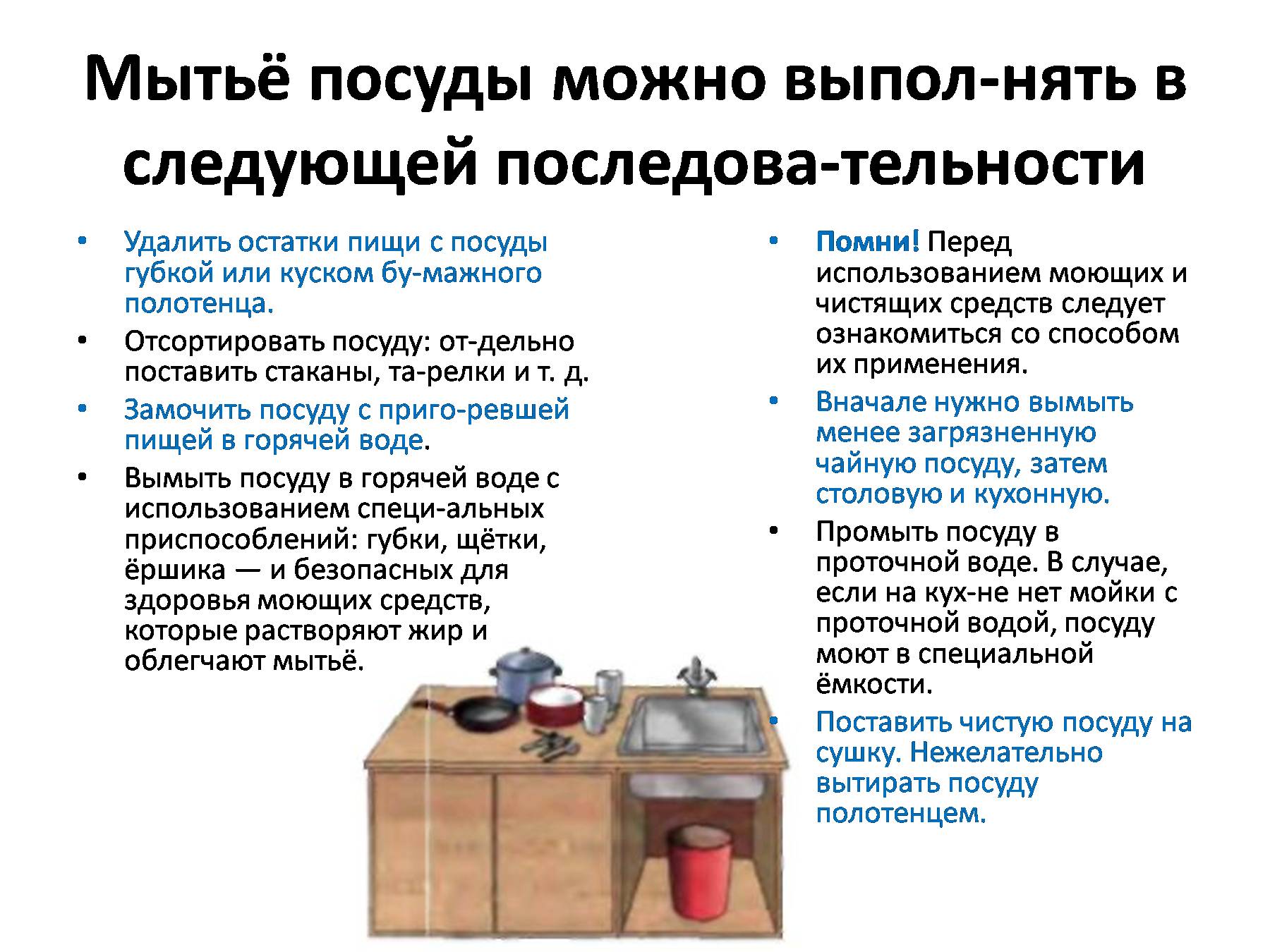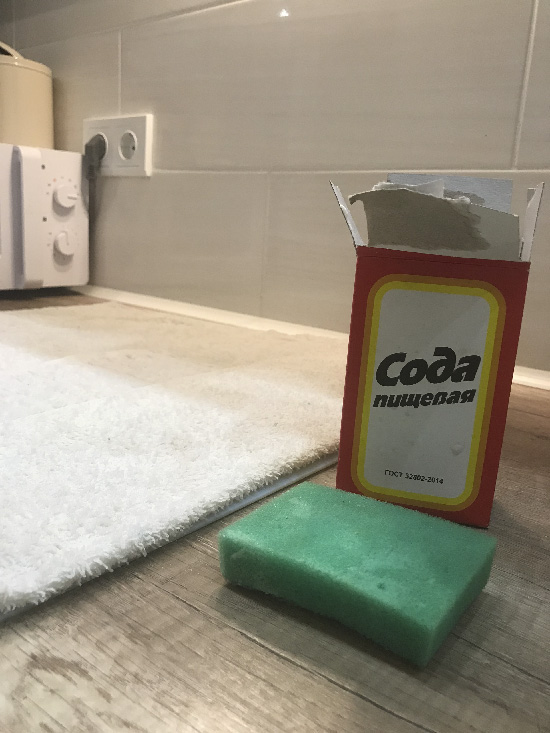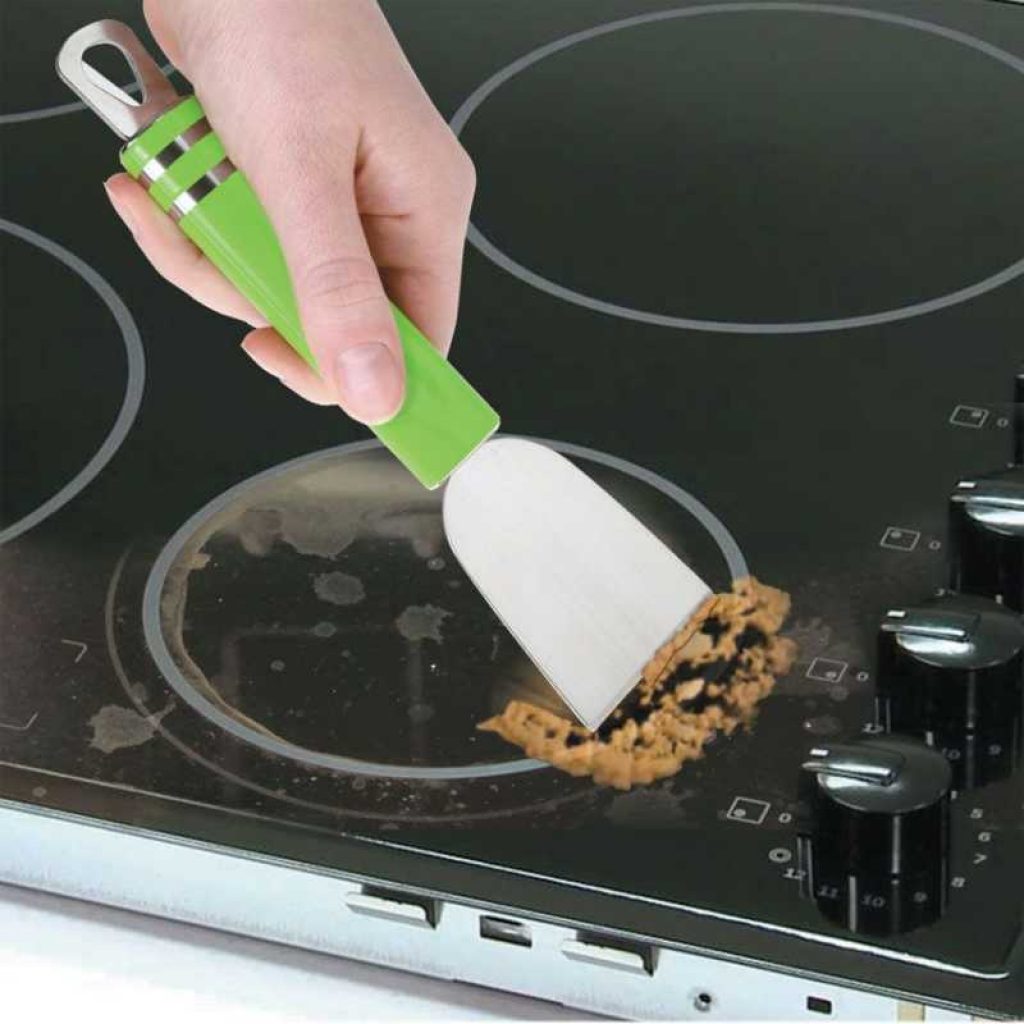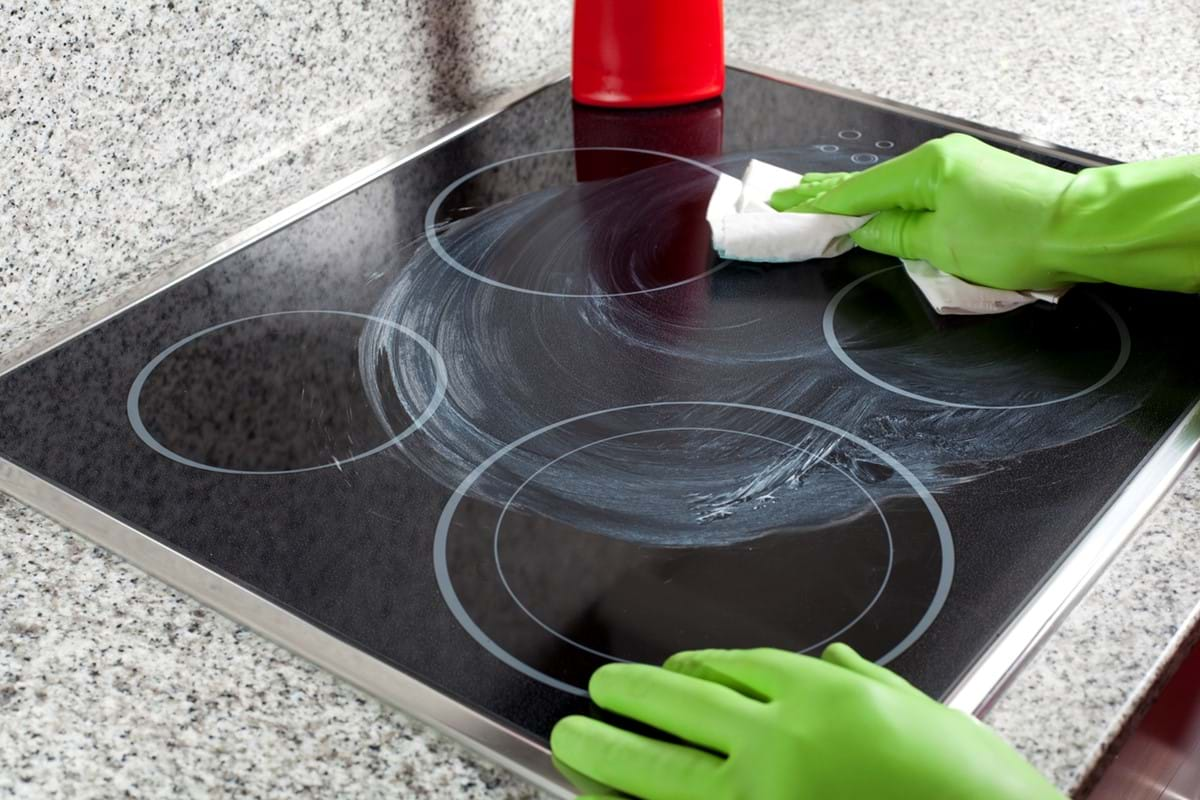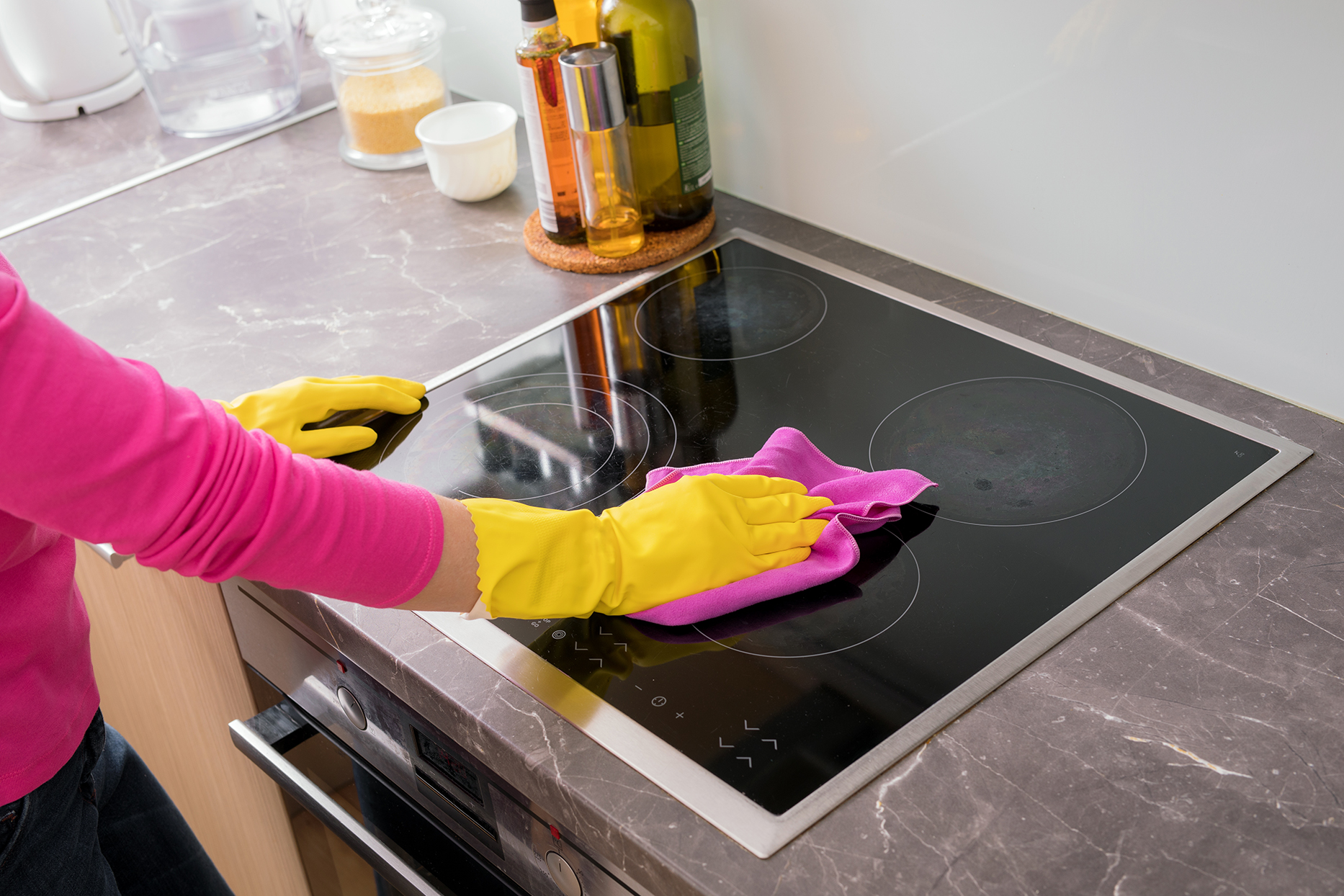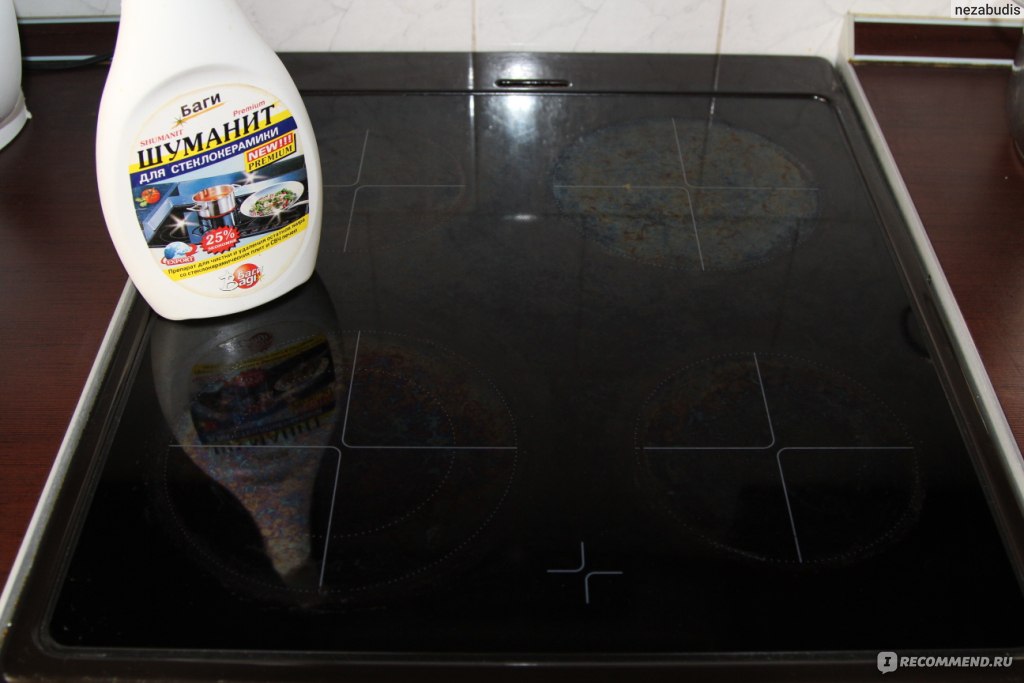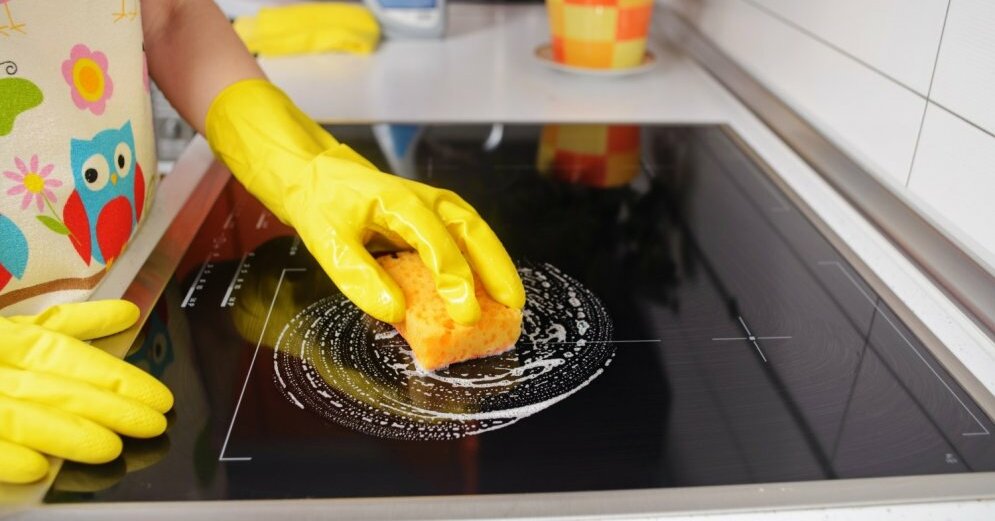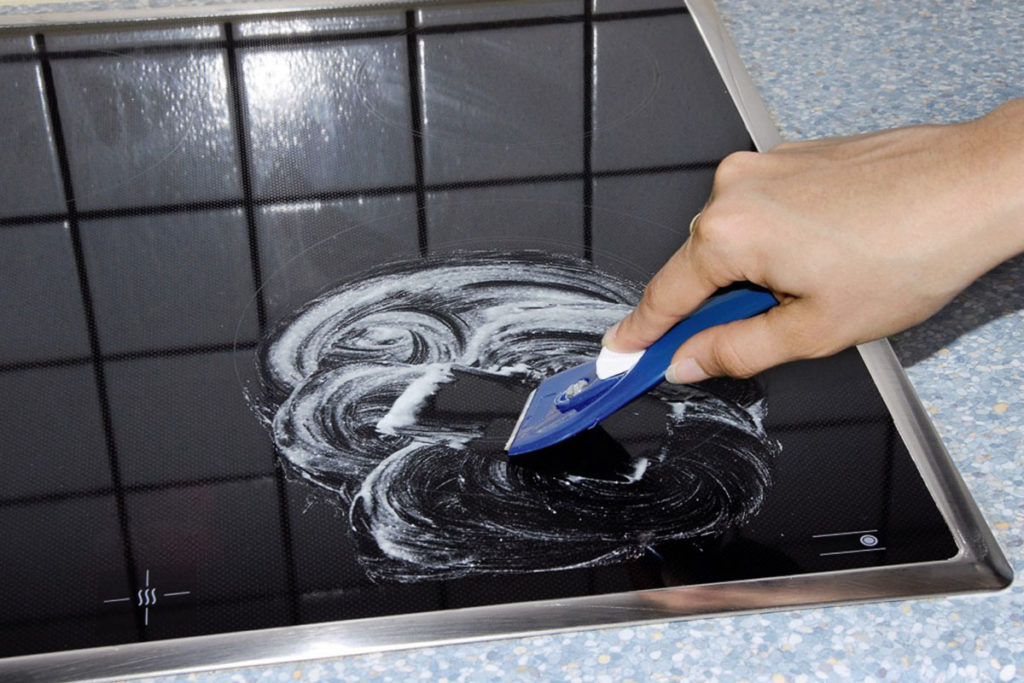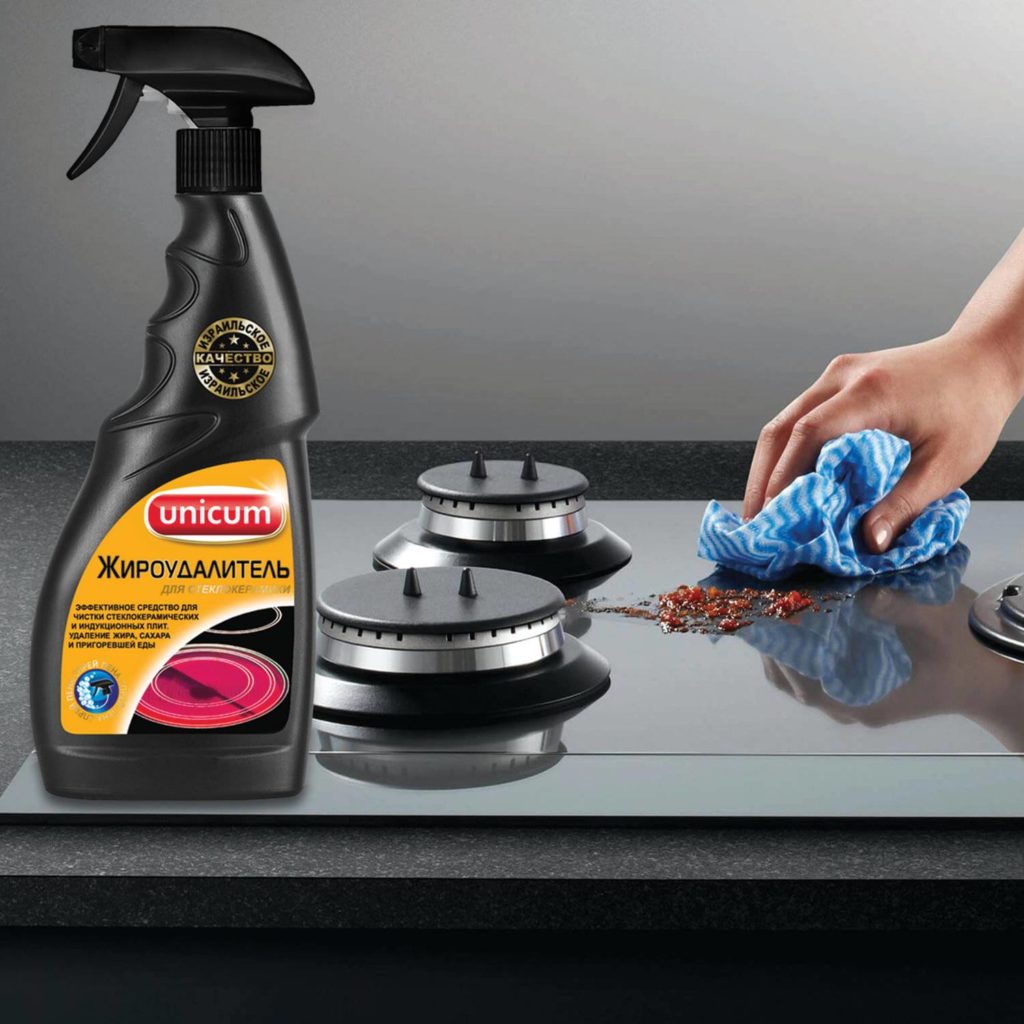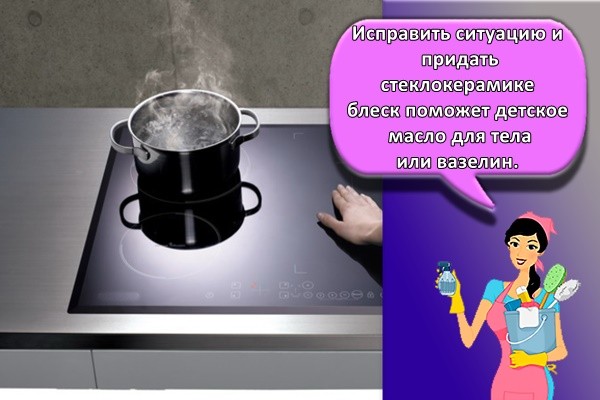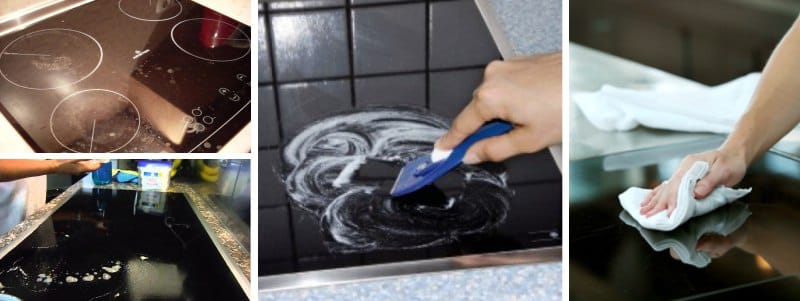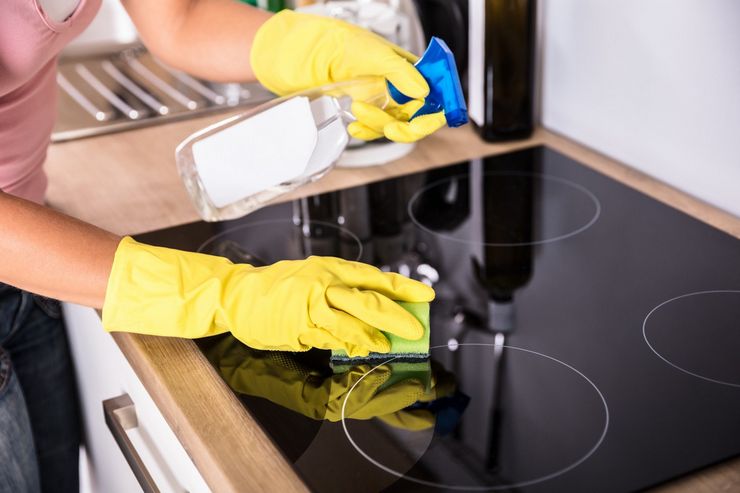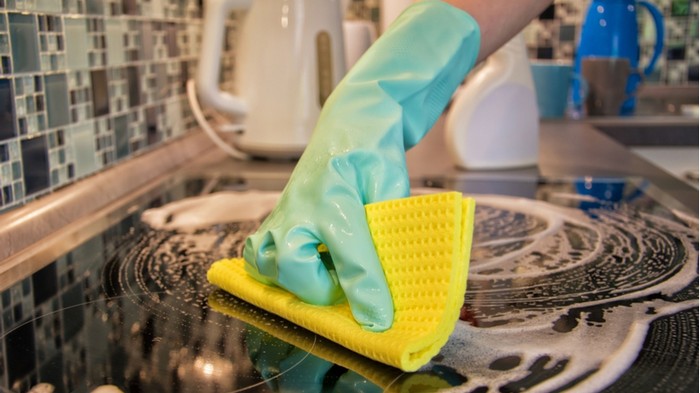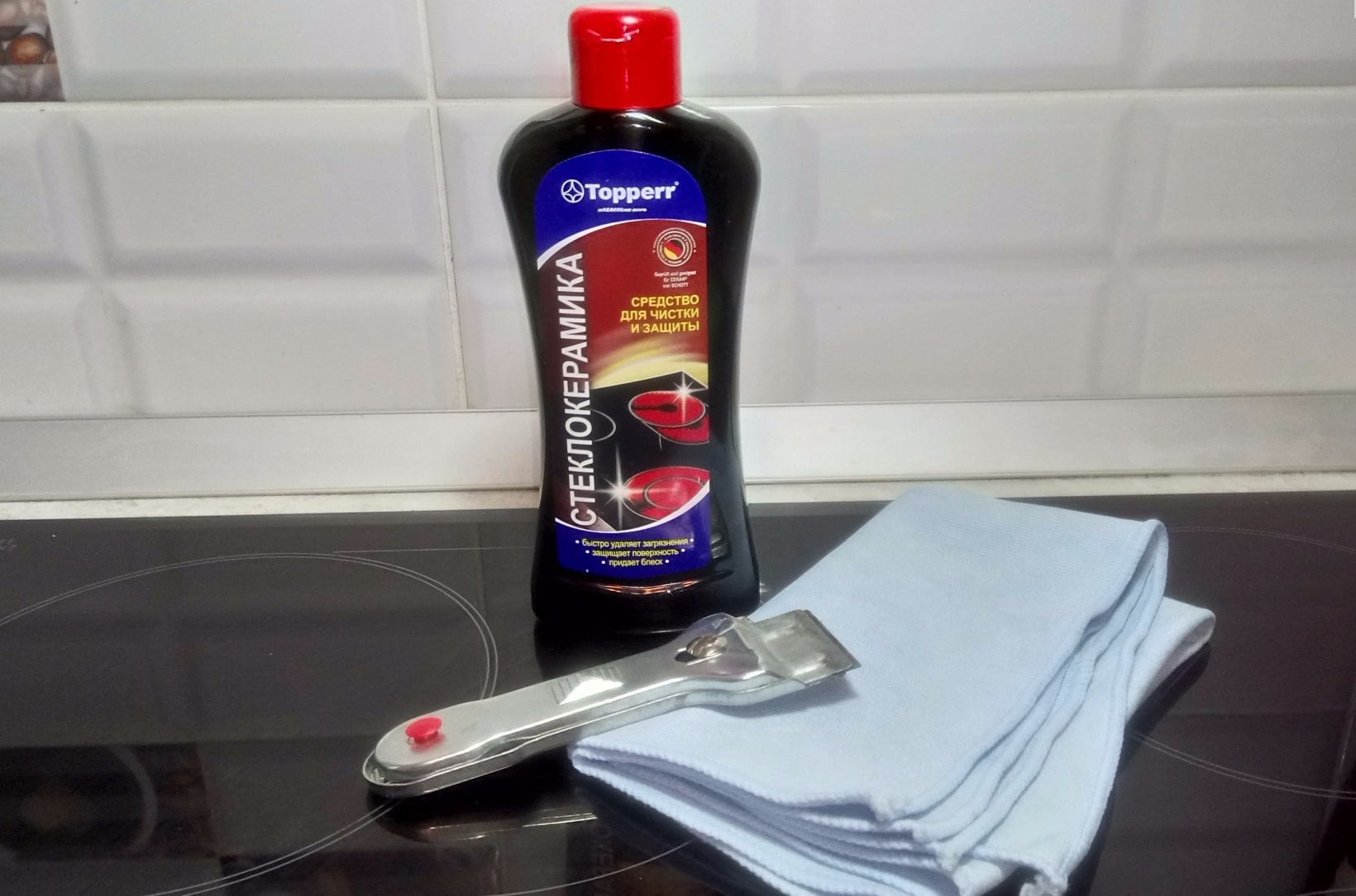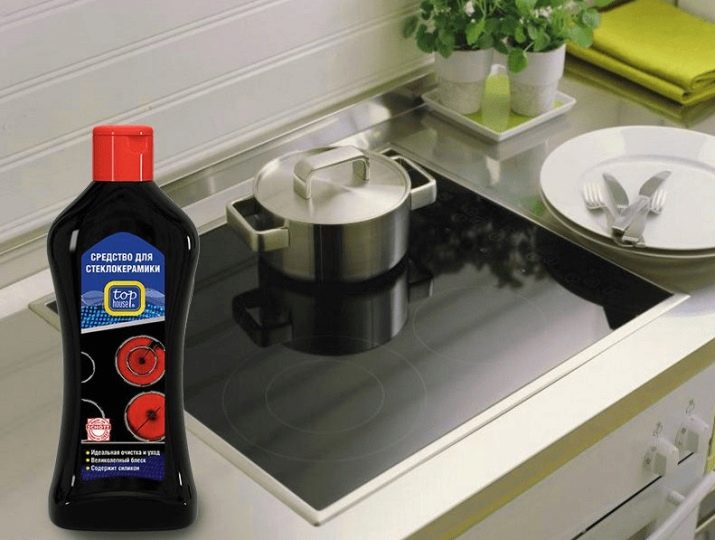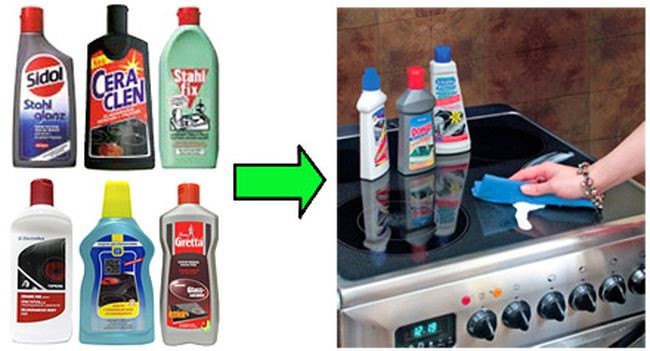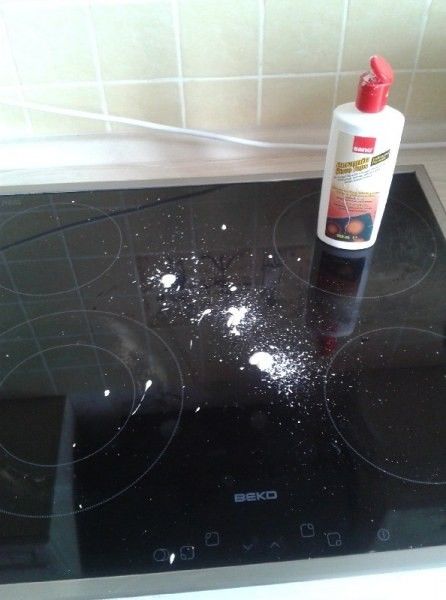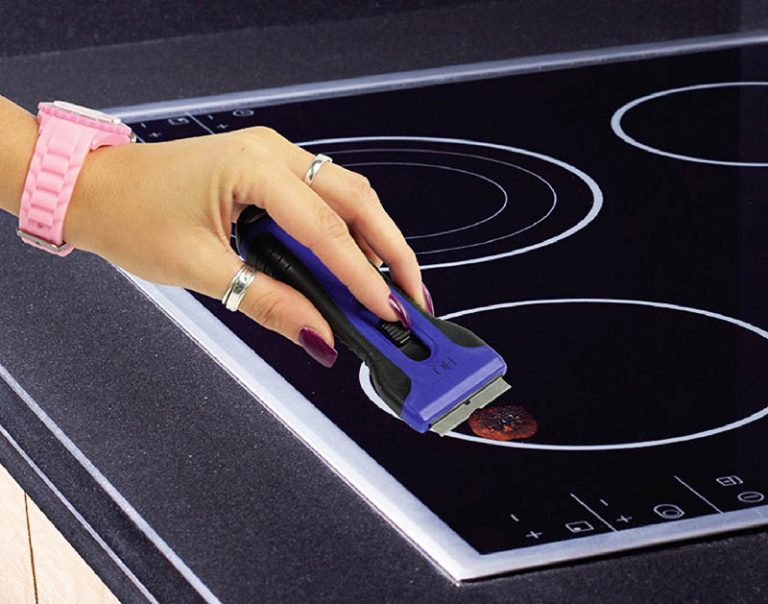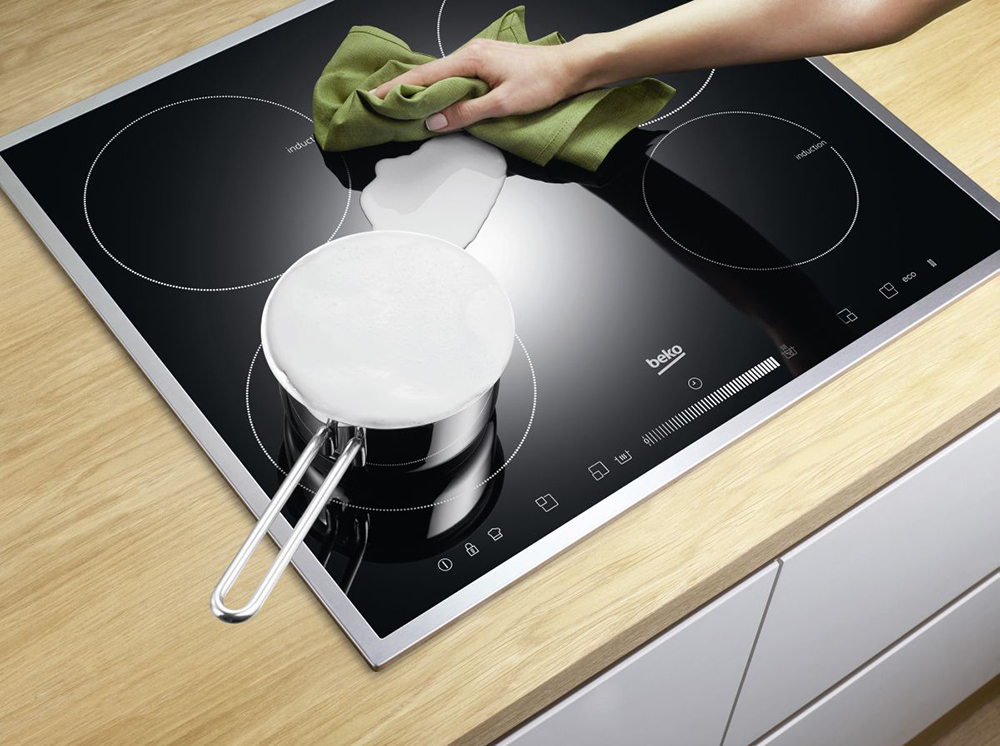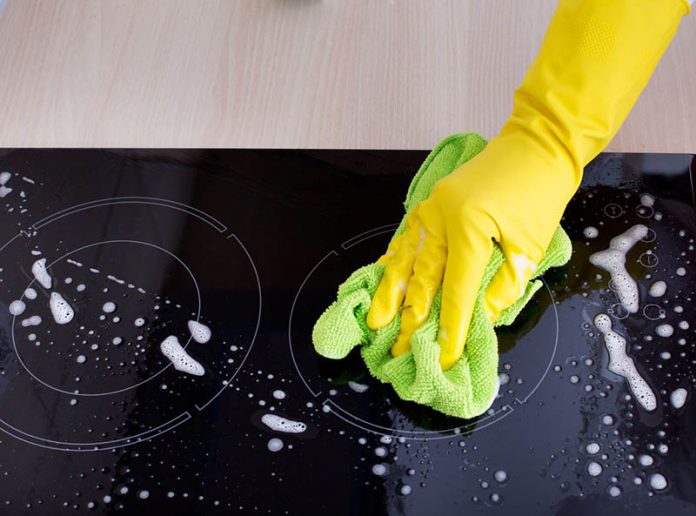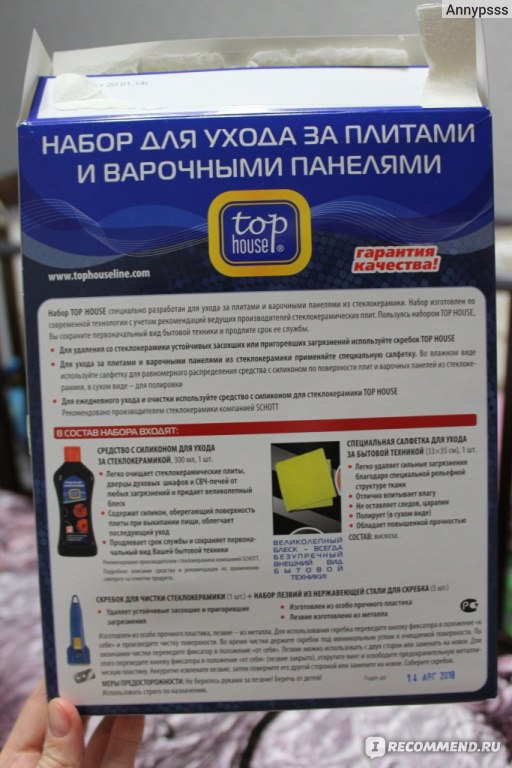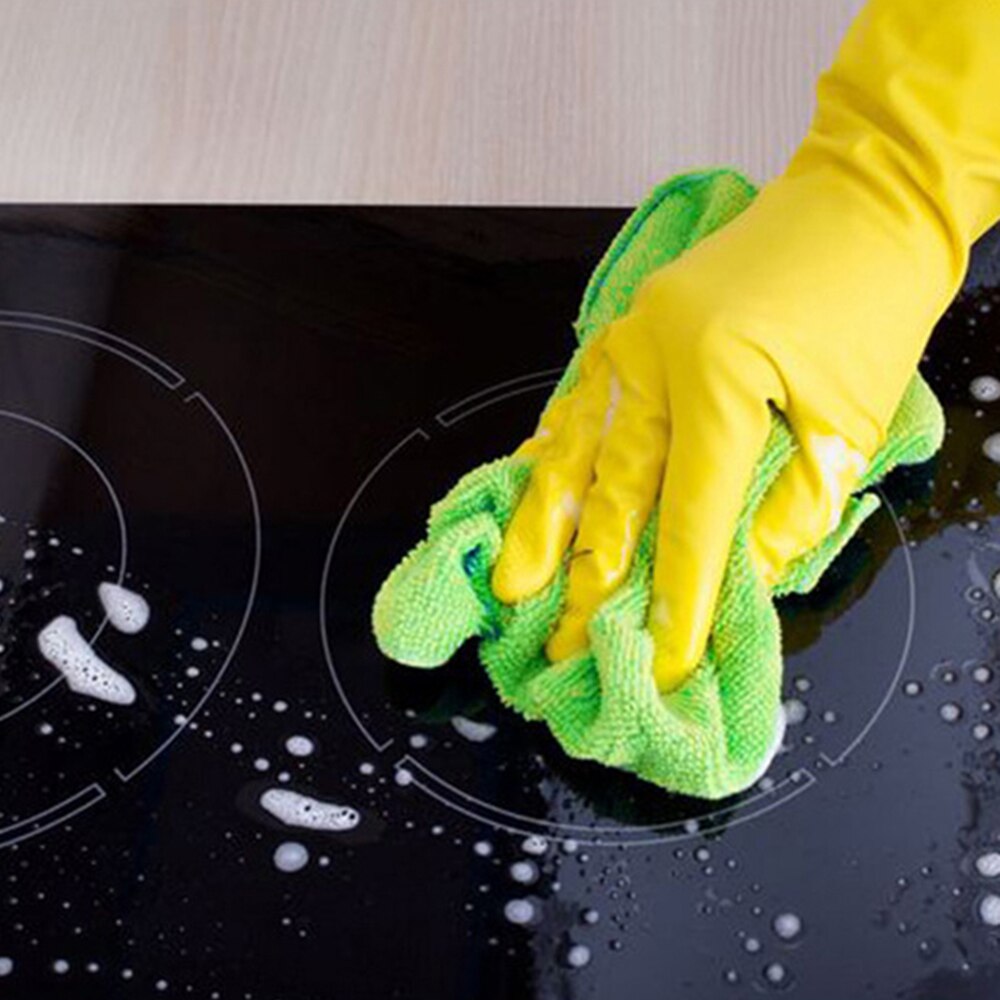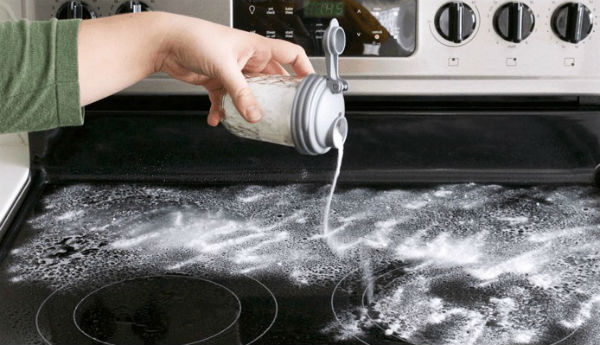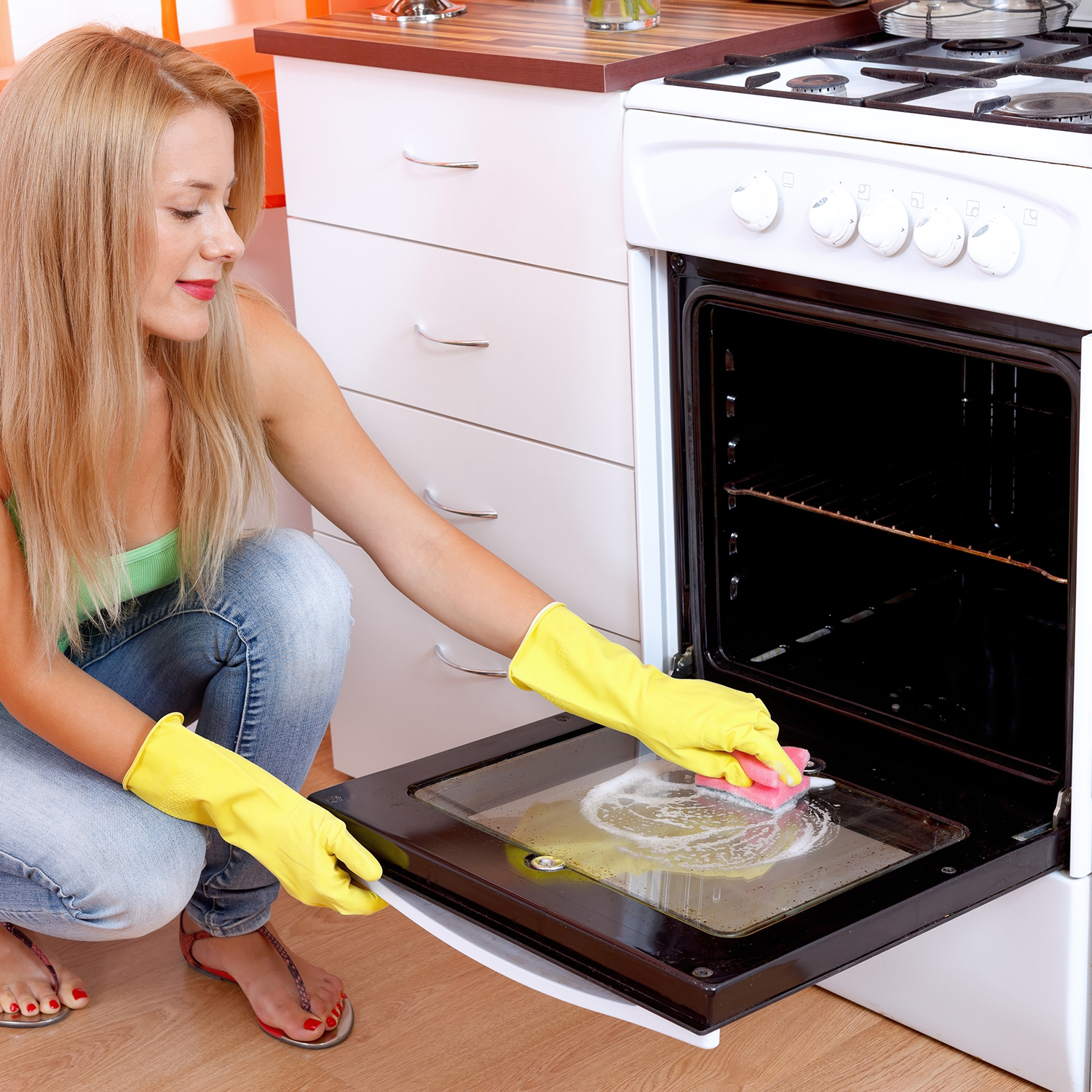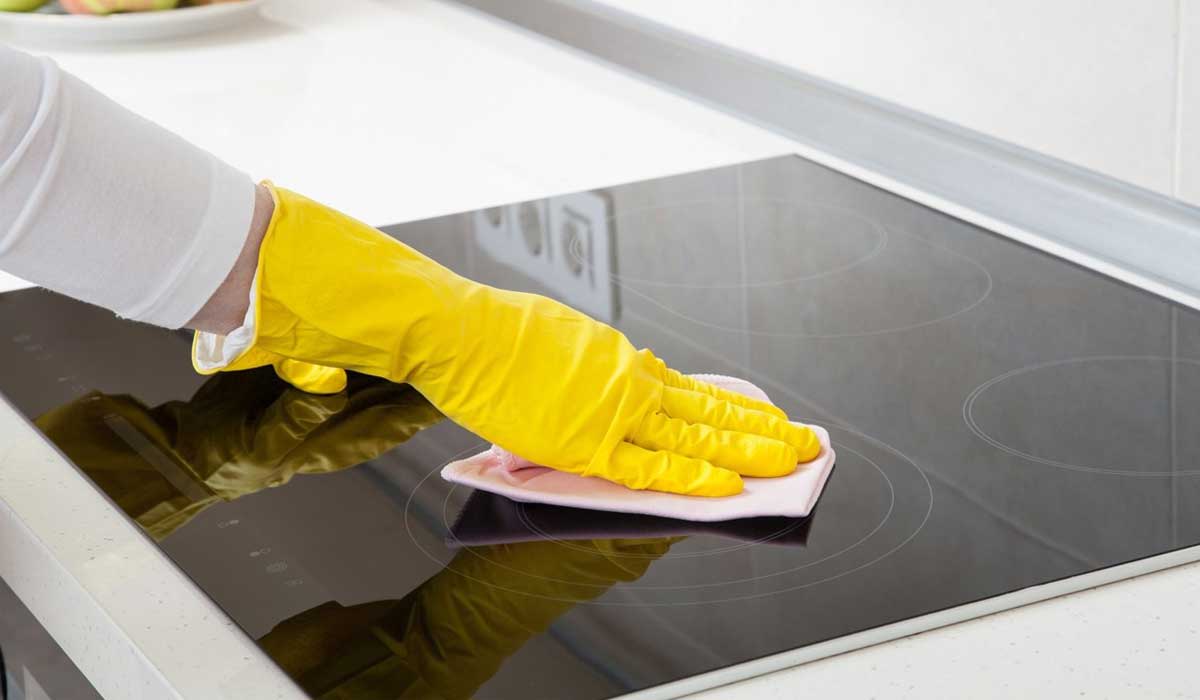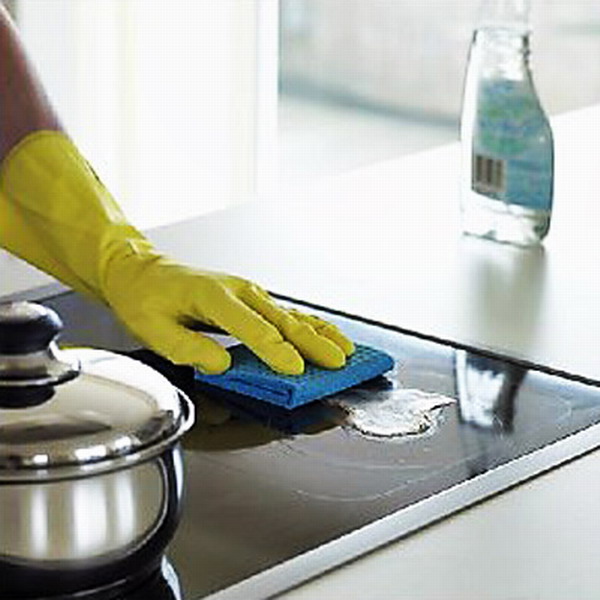Care of the glass-ceramic panel
The glass ceramic hob should be cleaned regularly and best of all after every cooking. Do not use scouring pads or abrasive cleaning agents for cleaning. Strong detergents such as oven sprays, stain removers and all-purpose cleaners are also not suitable for glass ceramics.
Together with the glass-ceramic hob, you should buy both a cleaning scraper and a special cleaning agent. These are all sold in hardware stores. Cleaning products for glass ceramics are produced by the manufacturers of such plates themselves. Sometimes these items can come with a stove, that is, their cost is already included in the cost of the stove, but in most cases they must be purchased separately.
The scraper can be steel or plastic. The latter has a short service life, so steel scrapers with removable blades are more popular. A scraper with blades is expensive compared to loofahs and sponges. For example, an Electrolux scraper will cost 160-180 rubles, and a set of 10 replaceable blades will cost 170-200 rubles. Special detergents for cleaning glass-ceramic surfaces are also expensive. True, they are enough for a long time, since the consumption is small.
You will have to buy a glass-ceramic cleaner, since it is much easier to keep the surface of the stove clean and well-groomed with it. Such a tool not only effectively removes food debris, grease stains, limescale. After its application, a very thin silicone film remains on the glass-ceramic surface, preventing the accumulation of food residues and grease stains. Thanks to this, the surface will be further cleaned much easier and faster. In addition, the film will act as an additional protection in the event that a liquid with a high sugar content is spilled onto the surface of the stove.
Before cleaning the glass ceramic hob, you must first remove any food debris with a scraper. When the surface is completely cool, apply glass ceramic detergent to it and rub it well with a paper towel or soft, clean cloth. Then the panel must be wiped with a wet cloth and finally dry.
Aluminum foil, molten plastic, burnt sugar, and other fusible materials must be removed immediately while they are still hot using a scraper. Then the cooled surface must be cleaned in the usual way. In the event that the burner with melted materials has already cooled down, it should be heated again and all dirt should be cleaned with a scraper.
In order to properly and effectively clean the glass-ceramic panel, a number of simple but very important rules should be followed:
- you should never wipe the glass-ceramic hob with the sponge that you use for washing dishes, as it will definitely leave traces of grease and detergent, which will burn when the stove is turned on again, and this will lead to discoloration of the surface;
- traces of water, lime, grease splashes, which can change the color of the surface, should be removed with conventional products intended for cleaning ceramics or stainless steel products. Avoid getting detergents on the hot glass-ceramic surface. After cleaning, all detergents must be removed from the glass-ceramic with plenty of clean water, since they can be corrosive during subsequent heating;
- the use of dishwashing detergents can cause bluish stains on the glass ceramics.They are quite difficult to remove even with the help of special tools, but they have little effect on the operation of the glass-ceramic hob. Lime stains can be cleaned with vinegar;
- you should not clean glass ceramics with oven cleaning sprays, but a glass cleaner may well come in handy;
- it is also necessary to ensure that the surface of the burners is always dry, since wet bottoms of pots and salt water can damage the glass ceramics;
- grains of sand on the surface, for example, when peeling vegetables, can also damage glass ceramics;
- glass ceramics are highly resistant to mechanical stress, but are afraid of pinpoint impacts. A crack on it can appear, for example, when the knife falls with the blade down.
Hob care
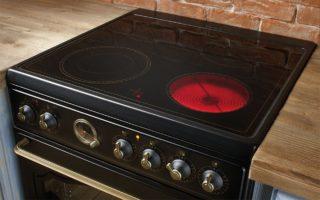 Glass ceramic plate.
Glass ceramic plate.
A glass-ceramic plate is a product that is demanding to care for, fragile and capricious, has a different color, the most common is glaze. In order for the product to perform its functions, you need to take proper care of the ceramic hob:
It is forbidden to place wet dishes.
For cooking on a hob, the dishes must be completely dry. Heating a saucepan with a wet bottom will cause white spots to form on the hob. It is extremely difficult to get rid of stains of a similar nature.
Therefore, it is so important to comply with this rule.
Do not use a scouring sponge when cleaning.
Caring for a glass-ceramic hob is reduced to the allocation of a separate sponge (cellulose napkin). Any greasy stains, food residues on the surface of the sponge - staining, damage to the hob. To work with the surface, use new, clean sponges, with maximum softness.
Sugar crystals - damage to the glass-ceramic coating.
The prospect of having molten sugar (caramel) sounds tempting. But, do not do this with a glass-ceramic stove. Imagine that in this case, caring for a glass-ceramic stove will require significant costs: physical and material for the purchase of an appropriate tool.
Caring for the glass-ceramic hob includes:
- Regular grooming and cleansing after every meal;
- Do not use abrasive sponges, abrasive kitchen and bathroom cleaners, oven sprays, stain removers, bath cleaners or general purpose cleaners to clean the surface;
- Before carrying out a thorough cleaning procedure, remove dirt, food debris with a special scraper (sponge). Apply a few drops of a special product for glass-ceramic surfaces (on a cooled stove), rub with a paper towel (rag). Now you need to rinse the surface with a wet rag, wash it dry, polish it with a soft coating of a special sponge;
- Choose the right cooking utensils. A prerequisite is compliance with the diameter of the pan and pans, the diameter of the burner. Choose cookware with a smooth bottom so as not to damage the stove. When hot, the cookware should be flat on the hob;
- Recommended bottom thickness:
Steel enamel - 3 mm;
Stainless steel with a multilayer bottom - 6 mm;
- Lift the dishes when moving them on the panel - this way you will be able to protect the surface and the stove from scratches;
- If melting substances come into contact with a hot surface, immediately remove everything with a scraper.
Oven care
Washing the oven is not a pleasant experience. Stubborn dirt accumulates on its walls and bottom, the lion's share of which falls on burnt-on greasy spots. With each cycle of heat treatment, they “stick” to the surface more and more. Therefore, to combat them, manufacturers are constantly coming up with new special technologies and materials.
Currently, there are ways to clean ovens such as:
- traditional.This method uses household detergents. It is not recommended to use abrasive products and tools, for example, dishwashing powders and metal sponges, as well as chemically active compounds containing acid and chlorine. It is best to use special sprays designed for the care of ovens;
- hydrolytic. In this case, place a baking sheet with water and detergent in the oven. Then the oven is heated to 90-95 degrees and kept at this temperature for about thirty minutes. Then the oven is turned off, allowed to cool, and all internal surfaces are wiped. At the same time, fresh grease stains are removed very effectively, but the cleaning process takes a lot of time;
- catalytic. The walls of the oven are covered with a special porous enamel, which, when heated to 140-200 degrees, absorbs fat, which then decomposes in its pores. After the oven has cooled down, the hostess just wipe it from the inside with a damp cloth. This method is one of the most convenient, but the catalytic properties of the enamel weaken over time and the catalytic panel has to be changed after 5-6 years;
- pyrolytic. With this method, the oven is heated to 500 degrees, so all the dirt inside it literally burns out, turning into ash. Such cleaning has one very significant drawback - high energy consumption.
How to wash the oven
It is not recommended to wash the oven with pastes and products containing various abrasives, as they leave scratches on the surface layer of any material, be it enamel, polished aluminum or tempered glass. For this reason, steel wool should not be used.
It is best to use special chemicals designed to clean the ovens from stubborn grease. It is best to choose a product that belongs to the category of environmentally friendly formulations. In such formulations, grapefruit or lemon oil is often used. They are very effective in softening even the oldest dirt, without causing any harm to health. Such products can be safely used to clean surfaces that are in direct contact with food.
The use of "non-ecological" chemicals is also not dangerous if used strictly according to the instructions. Most often, sodium hydroxide (acoustic soda) is used in such cleaning compositions, which is a very caustic alkali. It eats away any fatty deposits, but after using it, you must very carefully wash the oven with hot water.
Cleaning the oven with a chemical cleaner is quite simple. It is necessary to apply it to the contaminated surface and leave it there for a while. Then the softened dirt can be easily removed with a soft, damp cloth.
Folk remedies for washing the oven
Most often, a folk remedy such as a mixture of vinegar and baking soda is used to clean the oven. They must be mixed in a 1: 2 ratio. You can also add some water and dish soap. The resulting paste is applied to the walls of the oven and left for a while. Instead of dish soap, you can use a small bar of laundry soap. You can also wipe the walls of the oven with vinegar and sprinkle with baking soda on top. At the final stage, all internal surfaces of the oven are thoroughly wiped with a soft, damp cloth.
There is another rather effective folk way - ammonia and water. In this case, you need to take two containers. Pour boiling water into one of them, and ammonia into the other. The oven is heated to a temperature of 70 degrees and a container with water is placed on the lower shelf, and with alcohol - on the upper one. Leave both containers in the oven overnight. In the morning, take out the grates, add warm water and dishwashing liquid to the container with ammonia, and wipe the walls of the oven with this solution.
Baking powder removes grease stains from the enamel surface well. It should be applied to the stain, sprinkled with a little water and left for 15 minutes. Then rinse off along with the contamination. A mixture of soda and citric acid has the same effect.
About dishes
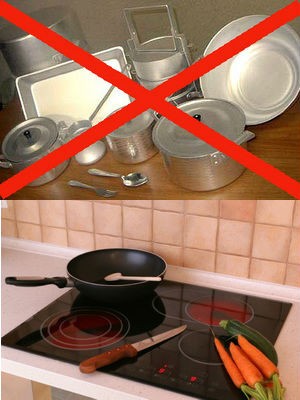 Do not be too lazy to study the instructions, as, most likely, there will be information about the optimal position, diameter of the dishes. Questions of what shape and size the kitchen utensils should be usually do not arise. Buyers are more often concerned about what material pans, pots and teapots should be made of.
Do not be too lazy to study the instructions, as, most likely, there will be information about the optimal position, diameter of the dishes. Questions of what shape and size the kitchen utensils should be usually do not arise. Buyers are more often concerned about what material pans, pots and teapots should be made of.
Manufacturers recommend to happy owners of glass-ceramic plates to purchase stainless steel dishes. Moreover, it is better if the marking 18/10 is indicated on the steel. This is the most reliable utensil. Why? Everything is related to the composition of the material. Chromium and nickel guarantee high wear resistance and hardness. You can also use enamel pots, the main thing is not to leave them empty on the included stove. This can cause permanent damage to the glass ceramic surface.
In the process of buying dishes, be sure to pay attention to the bottom, which should be as flat as possible, as well as multi-layered. Only thick-bottomed dishes will not deform when heated
Experts advise choosing pots and pans with a dark matte bottom, as they conduct heat better.
It is important for owners of stoves with induction burners to know that such models heat the dishes with eddy currents created by a magnetic field. Thanks to this, the surface of the slab practically does not heat up
When buying pots and pans for an induction cooker, it is important to pay attention to the presence of a magnetic bottom, without which the dishes simply will not heat up. It is very easy to check whether the bottom is magnetic or not. Take a small magnet to the store, if it sticks to the bottom, then you can safely buy the dishes you like
Note that utensils for induction cookers are made only of cast iron, stainless steel and aluminum (a special bottom is installed in aluminum dishes), so there is no point in considering other options
Take a small magnet to the store, if it sticks to the bottom, then you can safely buy the dishes you like. Note that utensils for induction cookers are made only of cast iron, stainless steel and aluminum (a special bottom is installed in aluminum dishes), so there is no point in considering other options.
It is not recommended to use pots, kettles, pans and other utensils used on traditional stoves. Why? The fact is that in this case there was an uneven heating of the bottom. As a result, the latter was deformed.
It is also worth refusing to use pots with aluminum and copper bottoms. When heated, the materials melt and leave stains on the glass-ceramic surface, which are very difficult to combat. It is not very convenient to use glass-ceramic and glass heat-resistant utensils, since they take a long time to warm up and cool down slowly.
The dishes have been chosen, but in order for the stove to serve for a really long time, it is important to remember three important rules:
The diameter of the cookware must be equal to or larger than the diameter of the hotplate.
The hotplate should be turned on after placing a pan or pot on it.
Always check that the bottom is absolutely clean and dry before placing the cookware on the stove.
Tips for keeping your induction hob clean
- It is recommended to wipe the hob with a soft cloth and a special detergent every day to avoid stubborn dirt.
- The stove can be cleaned only after it has cooled completely, otherwise stains may appear on the glossy surface.
- If there is noticeable dirt on the induction hob, and you plan to turn it on in the near future, it is better not to do this.First, you should remove the stains and only then start cooking, otherwise the remnants of previous culinary experiments can literally "weld" to the surface.
- It is strictly forbidden to use any abrasive products, both chemical and natural (soda, mustard, etc.). Even the smallest grains leave scratches on the glossy glass ceramics, and it will be impossible to get rid of them later. If you have a question "how to clean an induction hob?" - choose Shumanite for glass ceramics, and your kitchen will always be in order.
- To care for the stove, use a separate cloth, such as a lint-free microfiber, or use disposable towels. Hard sponges with a pronounced texture, brushes and metal scouring pads - all this cannot be used, so as not to damage the surface. Moreover, you should not use soft sponges with which you sing dishes or wipe tables - they may contain crumbs and particles of detergents, which are contraindicated in induction cookers.
Act Immediately
It happens that even the most careful and attentive housewives may not keep track of everything during active culinary experiments. Therefore, it cannot be ruled out that plastic objects, sweet food ingredients, baking foil and other things that can spoil the appearance of the stove on the glass-ceramic surface. If this occurs, the advice of experts is unequivocal - act immediately. Remove trapped dirt or foreign objects with a glass ceramic hob scraper. After a delay, they can melt and harm the glass ceramics.
Also, make it a rule to apply a glass ceramic hob cleaner to the surface before preparing sweet dishes. The product leaves behind a protective film, which is able to protect the coating from the ingress of sweets on it.
Glass ceramics is a fairly strong material, but still requires careful handling. Proper care of the surface and careful use of the stove will keep the attractive appearance and performance of the device for a long time. As a result, following simple rules and adhering to the advice of experts, it will be a pleasure to use a glass-ceramic hob.
Features of electric glass ceramic hobs
The basis of glass ceramics is the use of ceran material, which is characterized by increased impact resistance and low thermal expansion.
For your information! If water is poured onto the surface of a hot stove, then cracks will not form due to temperature differences. The average service life at home, which is guaranteed by the manufacturer, is 15 years.
Usually, these stove models are equipped with halogen burners or the High Light system, in which heating is provided by means of a special alloy heating tape located under the ceramics, wrapped in symmetrical rings.
Externally, glass ceramics is a perfectly flat surface that has a pleasant appearance. Cooking food for a long time will result in deposits, grease stains and other stubborn dirt. Therefore, each housewife will find useful information on how, and most importantly, how to clean a ceramic stove so that it retains its original appearance throughout its entire service life.
More on the topic “Cleaning the cooker: induction, glass-ceramic. What detergents to choose? ":
Praise the induction medium
With a regular sponge with dishwashing detergent, then with a wet cloth and dry. If something sticks, then with cleaning milk. We have two glass-ceramic burners, two inductions, a combined stove, so induction is ideal, but ordinary ones must be scraped.
LG Premium Embedded Home Appliances: Looks Great - Cooks Smart
LG Electronics (LG) has announced a premium line of built-in home appliances for the Russian market, embodying the perfect combination of design and functionality, so necessary for today's rhythm and lifestyle. All products of the new family are specially designed and manufactured to be part of a complete set of kitchen appliances, which includes everything you need to keep food fresh for a long time, as well as to prepare the most sophisticated dishes ...
Premium home appliances from Samsung
As part of the Samsung Art of House film festival, a new line of premium household appliances was presented. The event took place at the Na Strastnom Theater Center in the style of a film awards ceremony. The evening was hosted by Russian actress Valeria Lanskaya. Screened nine short films by aspiring Russian directors who took inspiration from the peculiarities of Samsung household appliances. The works of the festival participants can be viewed here. A new premium was presented ...
Glass ceramics or circles (pancakes) ????
I also choose an electric stove, but>. glass ceramics - induction. The mother-in-law came to visit her friends. I began to cook on glass ceramics like on gas - the stove burst. 7th year glass ceramics .. Washing is easier than pancakes. Sugar ... well, it was a couple of times - so immediately cleaned up and that's it.
Help! Gas hob.
I have Bosch, just glass-ceramics with large cast-iron grilles just black. I don't see anything whimsical - my usual means for glass ceramics, grates in the dishwasher. If I had thought about it during the repair, I would have chosen a different model of the stove.
Who has dishes for glass ceramics ????? crying (((((
Induction hobs can have a glass-ceramic surface. Cleaner for glass ceramics - Shumanit, for example, and buy a scraper and replaceable blades for it - and everything will be cleaned.
How to wash the scotch tape and a question about a glass-ceramic stove.
Section: Cleaning (glue to glue the glass-ceramic plate). How to wash the scotch tape and a question about a glass-ceramic stove. Even now I have enough detergent for six months with an ordinary stovetop. 09/16/2009 21:48:45, Beatrice. there is one iron rule for induction cookers ...
How to clean glass ceramics?
How to clean glass ceramics? Tell me, who cleans owls stoves with what? In the sense of glass-ceramic? In the same place as glass ceramics  There are also cleaning products. I bought at the Prague market (where electronics and household appliances).
There are also cleaning products. I bought at the Prague market (where electronics and household appliances).
Glass ceramic hob, care.
Glass ceramic hob, care. Tell me how to get rid of "rainbow" stains on the glass-ceramic surface of the stove. Means for washing glass ceramics are not removed (I used Bugs, Komet, Pemolux-cream)).
Silly hob question
I didn't want edging either. I chose in the end with edging, but from the same glass-ceramic as the surface itself. So far, only the stove cleaner gets into the slot at the edging :)) I wipe it off Here you need to wash it often, do not start it. 03/10/2005 13:16:28, Murzya.
Means for glass ceramics
Section: Laundry, cleaning. Means for glass ceramics. How do you wash / protect your glass-ceramic panel? Reaching a cream, it costs 20 rubles. It seems that it does not create a protective film, but even without it, my plate in between times, and I am not going to a feat, as it was with ...
How do I clean my electric stove?
there is a remedy called SANITA-gel. how to clean this stuff. I like 11/24/2003 22:55:46, Musya & Goose. Rules for the care of a glass-ceramic stove. how to get loose? lll. which sink would you choose? Vitamin.
How to clean a ceramic stove using scrap materials
In the absence of the opportunity to use chemical cleaning agents, folk recipes come to the rescue. There are many objects around a person that can be used as a cleaning agent.
How to clean ceramic hob with vegetable oils
One of the proven ways to deal with stubborn and persistent dirt on the surface of glass ceramics is to use ordinary vegetable oil.
To get rid of grease or carbon stains, soak a soft cloth or sponge with a little oil and place on the stain for half an hour. After that, the dried fat will become pliable and can be removed using your usual methods.
How to clean a glass ceramic hob with soda and lemon juice
The next reliable recipe for cleaning glass ceramic surfaces is to use a mixture of baking soda and lemon juice.
For your information! Do not worry that the use of baking soda will damage the integrity of the ceramics. It is a very soft abrasive that will not damage hard surfaces.
To prepare a cleaning agent, you need to dilute a small amount of baking soda with water to form a paste, which is applied to burnt spots of grease or food. The applied composition is left on the surface of the contamination for 10-15 minutes, after which the place is wiped with a soft sponge. If the stains are so severe that regular soda cannot cope, then a few drops of lemon juice can be dripped onto the soda patch. A violent reaction will lead to the fact that the remaining fat is quickly destroyed. This is followed by the usual wiping procedure with a sponge or rag.
Vinegar as a cleaning agent
What else can you wash the glass-ceramic panel with? Plain table vinegar. The positive side of this method is not only the ability to achieve a clean ceramic surface, but also the disinfection of the hob and other kitchen utensils. To prepare a cleaning solution, it is required to pour equal proportions of warm water and 9% vinegar into a spray bottle, mix it thoroughly and spray the dirt on the surface. After just a few minutes, the stove is wiped off with a clean paper towel.
Ammonia - replacing the windshield wiper
Another way that allows you to achieve the cleanliness of the glass-ceramic panel is the use of ammonia. It is required to add it in an amount of 50 ml to a glass of warm water and spray the resulting solution onto the surface of the stove. Next, you need to wait for 10 minutes, then remove the remaining dirt with a dry towel or napkin. In addition to removing stubborn stains, this method allows you to achieve the crystal shine of the ceramic.
Proper maintenance of the stove
No matter how you try to be as careful as possible, when cooking, the stove or hob will inevitably get dirty and must be cleaned and washed. The glass-ceramic surface requires careful maintenance. Do not use hard metal scouring pads, brushes, scrape the glass-ceramic surface with a knife, use ordinary detergents or abrasives.
What is used to clean the glass-ceramic surface of the plate:
- Scraper. Cleaning the glass ceramic hob begins with removing stubborn dirt and food debris. If plastic, aluminum foil, sugar or sugar-containing foods come into contact with the hot hob, remove them from the hotplate as soon as possible with a cleaning scraper. If this is not done in time, while the hob is still warm, they can damage the glass-ceramic surface.

Detergents. After thoroughly cleaning the surface, apply a few drops of special glass ceramic cleaning fluid to the cooled hob and rub it with a paper towel or clean cloth. Please note that strong cleaning agents such as oven spray, stain remover, bathtub cleaners or abrasive all-purpose cleaners are not suitable for caring for glass ceramics.Finally, wipe the hob with a damp cloth and wipe dry with the soft side of a special cleaning sponge.
Napkin. If you are using a cold hob as a work surface, be sure to wipe it down with a dry cloth after cooking. This will help prevent any remaining crumbs from scratching. And remember - when moving cookware, always raise it to avoid scratches and scuffs on the hob.
If not all stains have been removed, you can use baking soda for more stubborn stains. It is not dangerous to wash the ceramic surface with baking soda, as it does not damage it, despite its abrasive properties.
How to clean a glass ceramic hob with baking soda? Moisten the baking soda a little and apply on the most stubborn stains for a few minutes. After that, you can simply wash with water until the soda residues are washed off. In some cases, to clean the stove, you can drip a little vinegar or lemon juice onto the soda gruel. The incipient reaction with the formation of gas helps to clean the surface from deposits.
Bars care
The grates must be removed every time the stove is washed, the burners - as they become dirty, and the regulating knobs are only used for general cleaning. Enamel grilles are easy to clean. This can be done with a dishwasher. For manual cleaning, use the same products as for the stove itself. If the grates are very dirty, then they can be placed in a bowl with hot water and detergent, where they can be left for a while.
Uncoated steel grates can be cleaned with a wire brush or any abrasive. It is not recommended to use any acid, including vinegar, to clean such gratings. Cast iron grates are the hardest to clean. Dry them after each contact with water to prevent rust formation.
Cast iron grilles must not be cleaned with metal brushes and generally must be handled with great care, as they may chip on impact. Heavily soiled cast iron grates can be cleaned with a fire
To do this, it must be held over the fire until all the impurities are burned out.
The adjusting knobs can be made of stainless steel or plastic. In both cases, they must be removed and immersed in a soapy solution for a while. When all the dirt is removed from the handles, they must be rinsed, wiped and reinstalled. The non-removable handles are somewhat more difficult to clean. For everyday cleaning, you can use a solution of ammonia and water, and for general cleaning it is better to use a detergent and a toothbrush. You can use a toothpick to remove any dirt that has accumulated under the handles.
Oven
Modern ovens are equipped not only with a variety of functions for cooking, but also with automatic subsequent cleaning modes. But the hands of the hostess will still be required. After self-cleaning using the built-in system, wait until the cabinet has completely cooled down - this will take at least two hours. If the inner surface was cleaned of dirt by high temperatures, then the first step is to collect the remaining burnt particles with a dry cloth or brush, and then wipe it with a slightly damp cloth.
Removable grilles also require cleaning with water or soapy water. On a door with a glass insert, apply a little special cleaning agent in the form of a spray and gently wipe off with a lint-free cloth - it is convenient to follow the preparation of the dish through the transparent glass without streaks.
Cookware according to the compatibility of the panel with the material of the utensil
Housewives, when buying a new stove, often change pots and pans, and wonder whether it is possible to put ceramic dishes on a ceramic stove?

You can set a certain heating power for the hotplate, and it will increase or decrease its power on its own.
Depending on which heating elements your stove is equipped with, it is necessary to choose dishes, now manufacturers put compatibility markings on their products, which will allow you to navigate in a variety of types.

As a rule, cookware for classic hobs is more diverse than for induction models made of glass ceramics.
The main thing is, if you have a combined model, choose cookware that is combined with different heating elements. The best choice is metal cookware that is compatible with induction and electric heating.

When choosing one or another dish, you should pay attention to the features of the production material, functionality and bottom thickness.

